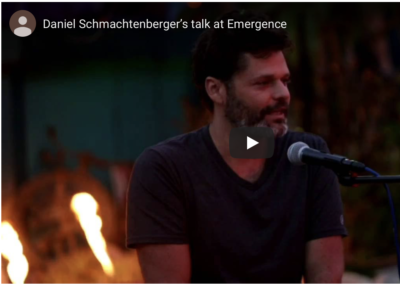One, I love challenging myths. It’s fascinating to me to see how an idea, once fuzzy and only one of many choices, can become calcified in certainty and encrusted as habit and insulated truth. Whether that’s simple stuff like cutting the ends off the roast, as Grandma always did (aha, to make it fit in the pan), or more involved stuff like attributing all power and intelligence to an individual leader (aha, it turns out the group can be smarter and more sustainable).
Two, I often find myself trying to “buy room” with people I’m working with by inviting the term “culture change.” It has enough legitimacy to shift attention from projects that are good, but only part of the puzzle — most people know this but just need a bit of leadership support to see the bigger picture. Culture change invokes seeing more of the horizon, more of the forest and not just the trees. It invokes a change of being, not just more fierce commitment to managed doing.
Three, I love what Chris Corrigan wrote on this topic recently. Chris is smart as hell and fiercely committed to the dynamics of the system at work. He is a myth buster among many things, who offers grounded tools and theory to change even the myths about change.
Changing the dynamics of how a system of people interact with one another is the game. It is setting the table for emergence to occur — the naturally arising dynamic of life. It is helping people, all of us, experience being in relation with emergence and growing in our comfort to be in the clarity and messiness of that. Pause with that thought — it is key — being in relation with emergence.
Culture change is not selling a grand idea and manipulating others to get on board with power, coercion, or even charisma. The game in culture change, the real importance, is a process change in how people engage with one another. Culture change is less planned and managed. It is more encountered and adjusted. What would it take for any of us to be more comfortable with encountering and adjusting with each other?
Check this from Chris’ site. I love his articulation and think out loud ability, to take on a myth.
Principles
- Culture is an emergent set of patterns that are formed from the interactions between people. These patterns cannot be reverse engineered. Once they exist you need to change the interactions between people if you want to change the patterns.
- Culture includes stories but it is not a story. This is important because simply changing the story of the organization will not change the culture. Instead you need to create ways for people to interact differently and see what comes of it.
- Cultural evolution is not predictable and cannot be led to a pre-determined character. You can aspire all you want to a particular future culture but it is impossible to script or predict that evolution.
Practices
-
Start by getting clear about the actual work. In my experience people use the term “culture change” as a proxy for the real work that needs to be done: improving employee relations, becoming more risk tolerant, shifting leadership styles…whatever it is, it’s best to start with getting clear what is ACTUALLY going on before assuming that the problem is the “culture.”
-
Look at what actually is. Studying the way things are is important, because that helps you to identify what you are actually doing. It seems simple, but it’s important to do it in a way that doesn’t bring a pre-existing framework to the work. You have to look at the patterns from the work that you already do, not from how it illuminates a pre-existing model.
-
Work with emergence to understand patterns together. Using tools such as anecdote circles, organizations can discover the patterns that are present in the current environment. Anecdote circles generate small data fragements that describe actual actions and activities. Taken together and worked through, patterns become clear, like the process of generating a Sierpinsky triangle. Out of large data sets, hidden patterns appear.
-
Identify those patterns and discuss ways to address them with safe to fail experiments. Run a session to create several ideas that are coherent with the patterns, design multiple small experiments to try to shift the patterns. Institute rigorous monitoring and learning and allow for experiments to fail.
-
Support new ideas with appropriate resources. If you really want to change the interactions between people you need to resource these changes with time, money and attention. The enemy of focused innovation is time. Even allowing employees to work on something a half day a week could be enough to create and implement new things. Butif they have to do it on top of the full workload they have, nothing will get done.
-
Learn as you go. Developmental evaluation is they way to go with new forms of emergent practice. To be strategic about how change is happening, it’s important to design and build in evaluation at the outset.





